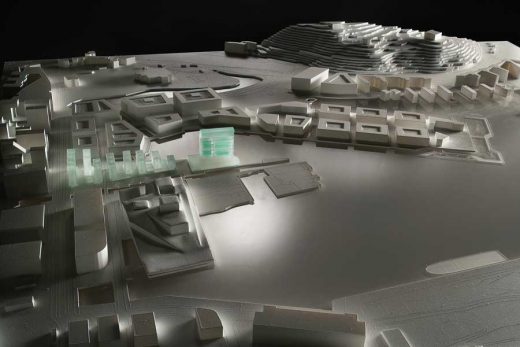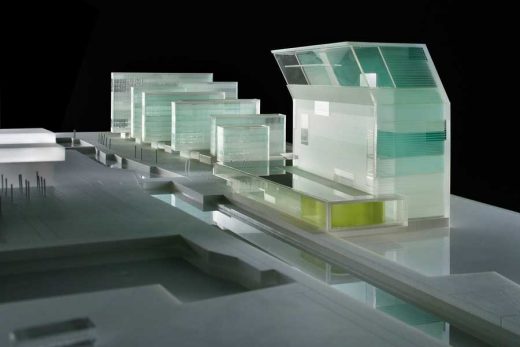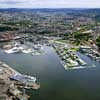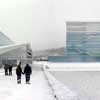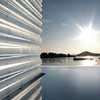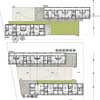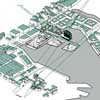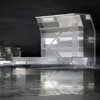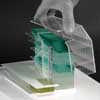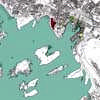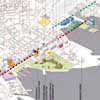Munch Museum, Norway Building, Project News, Design, Property Images
Munch Museum Norway : Norwegian Architecture Contest
Competition Win by HerrerosArquitectos in Oslo, Norway
21 Apr 2009
Munch Museum
Lambda proposal for the Munch Area Oslo Competition
MUNCH AREA / Lambda
the munch museum
and the stenersen museum collections
Design: HerrerosArquitectos
I am more interested in the line, its rise and fall, than in color – Edvard Munch
Models by Jorge Queipo, photos by Federico López
International Competition by Invitation. First Prize
Project slated for completion by 2013
Client: HAV Eiendom AS, Oslo Kommune
Introduction
DIAGNOSIS AND POSSIBILITIES
The competition for the Munch Area in the Bjorvika neighborhood involves an opportunity to develop a complete city fragment in an enclave soon due to become essential for Oslo’s life and image.
The recently finished Opera house, the BarCode complex under construction, the projected Library and the Munch Museum and the planned housing, offices and shops will end up extending the city centre and opening it out to the sea, thus ending the historical rejection that so many coastal cities have maintained with respect to their coastlines.
On activating Oslo’s desire to show itself as a multifunctional “fjord city”, we are consciously designing the postcard that everybody wants: the front of the city and its geographical context at the end of the fjord. This is where nature capital and historical memory intersect in order to project a future vision of an active and diverse city.
In this regard, we believe that our aim is for an action that shapes the city in terms of its social geography, urban multi-functionality and environmental sensitivity, that, together with a reflection on its density and diversity, we can together forge cogent growth for Oslo. We celebrate the disposition shown for the modeling of a compact city, on a human scale, in which all the pieces weave a series of relationships that serve to contradict the usual tendency of working on
schemes of isolated campus-type gestures.
We interpret the opportunity offered by the central piece of the proposal, the Munch Museum, to develop a contemporary museum concept, one which does not only refer to art custody and exhibition, but which also develops an urban role of responsibility as a cohesive element of public projection for the community it serves.
Urban planning, context and public space
GENERAL CONSIDERATIONS AND FIRST DECISIONS
The focus of this urban project is centered on the necessary relationship between the desired areas and the existing city in the unique context configured by the fjord, coastlines and geographical features that condition it. We are not proposing a site with isolated phenomena. We propose a dynamic, fruitful conversation with the surroundings, a proposal that selects the appropriate uses, scales and densities that in turn articulate the spatial forms of occupation, the dimensions and treatment of the public space and its sustained growth towards the future.
The first guideline of our proposal is a sequence of connected public spaces that are strongly characterized and sufficiently large to formulate a dialogue between the scales of the architectonic features of the area, thus integrating them into a general, readable system. Secondly, we will detail the built programs to corroborate with the suggested locations of the Master Plan: we locate the museum in the B-11 lot and then the housing programme in lots B-4 and B-5, maintaining a steadfast suggestion to stagger the heights of the buildings towards the sea. For the residential area we have chosen an organization of blocks which are parallel to the city and slightly displaced with each other in order to ensure continuity of views and visual richness of urban perspectives which are rounded off in a square resolving the transition on through to the Museum.
The Museum is developed with slight verticality, choosing a posture which shows a double attention towards the fjord and towards the city, standing respectfully to the east of the opera house, thus extending and completing its silhouette. With these decisions we confidently intend to work on the visibility and perception of the set of buildings, from the city, to the fjord, to the high areas from which the history of Oslo will be understood in one coherent image.
The ground plan takes on great importance in our project and we imagine the set of the public space + ground floors of the building as a plan with great dynamism and leisure, commercial and productive activity, designed in detail and intensely “naturalized” and accessible, which attracts a flow of users which is not limited to residents and tourists.
This will be the base for the new central nature that we want to stamp on Bjorvika and which explains our efforts in rounding off the system of public spaces generated with a unique action in the islands and the beach which open onto the fjord, and providing these privileged places with landscaped and programmed attractions so as to ensure that they are used intensively by the public.
It is worth saying now in advance that we leave the small island on the south of the Museum free, which may become a complementary enclave to the museum, and the Snelda island for which we propose a sporting and hedonistic program related to contact with the sun, the wind and water understood as urban water park or a natural park. In the peninsula adjacent to the opera, we maintain the plan of locating a beach, a tourist port and bus stop for the buses which will serve the museum, the port and the water park.
The series of attractions is completed with the location, still tentative, of the cable car which may strengthen the nature of the area as a setting for walks, shopping and free time with an array of cafes and terraces combined with workspaces. In any case, we have tried to respect the rules and instructions of the bases, opting for the flexibility which they favor in certain cases, especially when referring to the heights, built areas and densities and programs. However, we must insist on the open nature of a proposal which is simply a diagram of possibilities and which will easily accept corrections and comments from the bodies involved in its development.
Munch Museum Spaces
Organisation of public space: the fjordside walk
The Seven Commons and the Harbour Promenade, the meeting of the city with the water and the obsession of making all the edge accessible, indicate a commitment with a high collective content for this new city centre. Our project proposes a series of spaces which use the slivered water mirror, the surrounding fjells, and the vibrancy of the city to create a major attraction—Oslo’s new public waterfront. A careful design on the water edge will emphasise the unique
qualities of this very special place in the world.
While waiting to know more about the presence of archaeological remains which may influence the proposed treatment, we have tried to design the fjordside promenade in a way that uses the natural assets of Oslo and makes Björvika into an experience of spaces that is unique to this particular landscape setting.
This sequence of spaces can be defined as:
1. The Leisure Island
2. The Beach Area
3. The Canal Walk
4. The Museum Island
5. The Munch Plaza
6. The Library Plaza
7. The Bispekaia Market Square
8. The Housing Courtyards
THE LEISURE ISLAND
The Leisure Island is a new generation public space. On the one hand, it is a place for active public life, and on the other hand a peaceful setting for individual silence, contact with nature and body fitness. Collectivity and isolation come together in this central place on the edge of the city. It is also the largest public space on the waterfront, located strategically with views on the fjord and with the Opera house to the north. The Leisure Island is designed to be a destination in itself, an urban park that attracts people from all over the city. The Leisure Island is conceived as an urban water park with swimming pools with water heated by geothermal energy, solariums and other natural activities.
It is an enclave with a high hedonistic content with shaded areas for rest and social life and some pavilions with a café, dressing rooms and silent space. Towards the south the Leisure Island has a wind screening wall of wood, which opens up in the middle part, creating a framed view towards the fjord. A small grove of trees gives structure to the island—Sorbus aria, a tree species that can endure hard winds and salty ocean spray.
THE BEACH AREA
The silent and peaceful idea for the Leisure Island contrasts with the bustle and activity of the Beach Area, understood as a sequence of terraces that lead down to the water. It goes from stone paving on the top, more socially inviting wooden terraces for sun worshippers below and ends at the yet softer sandy beach. A pier with a rounded endpoint permits disabled people to get to the lower levels on ramps and also creates a sheltering wall to the south, as well as a viewing point at the end, from where the sunset can be enjoyed. Because of their size, accessibility and features, both the Leisure Island and the Beach Area could host concerts and open-air events during the summer.
THE CANAL WALK
The Canal Walk is an essential piece of the public space, which accompanies the river and carefully treats the river banks as a place to be, for sunbathing and nautical activities. On the side of the opera house, the existing project and the plan for mooring for small boats is respected. On the project side, we respect the planned geometric line treating the public space as an extended plaza lined with trees in an informal way and which may be used for strolling, relaxing and as an
esplanade for rowing. The Canal walk leads up to the main entrance of the museum and also continues to the Museum Island. The Canal Walk is lined with a low wooden wall for seating, interrupted by a rhythm of small platforms facing the canal and a series of small ornamental trees, Acer tatarica, a tree with a strong character and a beautiful autumn colour.
THE MUSEUM ISLAND
The Museum Island points as an index finger out towards the fjord. The direction is noticed already along the canal Walk in front of the main entrance to the museum. It could be totally public or understood as an element of the Museum with restricted access. Approaching the island, there is a choice between moving to the Orangerie with its collection of Citrus trees and displayed objects of art on the one hand, and moving up the ramp towards the elevated sculpture terrace on the other. The ramp is initiated with a wooden wall which screens off the view to the north during the walk upwards, again just to display the view in all its magnificence once up on the elevated sculpture terrace.
The wooden wall also acts as a climate shelter, making the lower terrace with its sunken herbaceous garden into a more intimate experience of scents and colour. This terrace can also be used as a reception area for the museum at openings. The terrace ends with the prow, where the visitor meets the sensation of being in solitude with the fjord landscape, almost floating between the water and the sky.
THE MUNCH PLAZA
The Munch Plaza is designed as a grove of trees, announcing the museum entrance area from the distance in all directions along the harbour promenade. The trees are Gleditsia Triacanthos “Skyrocket”, a hardy enough tree with a semi-transparent canopy that filters the light softly to the ground. The grove acts as an intermediating zone between the museum in the south and the housing in the north. The grove is also an assembly point for visitors before moving on to the main entrance, and also provides shaded rest areas, defining the edge of the museum complex. If the Cable Car is finally built, it could start from this square and thus complete its programme of Activities.
THE LIBRARY PLAZA
The Library Plaza contains the upper part of the canal and has wide seating stairs in a playful geometry on both sides, connecting down to the water. The water is treated artistically to make it a showpiece, maybe with a maelstrom/ whirlpool effect. On the upper level on both sides are groves of trees with park sofas under the canopies. The groves are Querqus Palustris on the western side (autumn colour, regular branch structure) and Fraxinus Excelsior “Westhofs Glorie” to the east (exotic leaf, autumn colour).
THE BISPEKAIA MARKET SQUARE / ICE RINK
The Bispekaia Market Square is more of a community plaza and recreational space for the locals. The southern side has an open quay character with water from the fjord coming in, creating an open basin. The basin is lined with shading trees and seating. The northern part is livelier and has a central gravel surface with space for market stands of varying kinds. In the evenings, boule players and other urban social entertainment take place here. In the winter time, the gravel surface is made into an ice skating rink.
THE HOUSING COURTYARDS
These are basically private spaces for the housing. The Housing Courtyards are elevated over the streetscape, creating more private, secluded courtyards that contain seating areas and smaller playground features. The groves are of Sedum and some bushes which play with the presence of other plant treatments in the corridors, terraces and gaps proposed in the buildings as common areas.
Traffic solutions and mobility
We suppose Dronning Eufemias as the main traffic artery and we propose a gradient of reduction in its intensity towards the south. In fact, we maintain the idea of restricting the traffic in Operagata and from there we only launch the service circulations necessary for the Museum and the tourist buses. As a whole, the project insists on the predominance of the pedestrianized and cyclist city with a significant presence of public transport which makes this possible. To make it
even more visible, we reserve practically all the available ground for people, minimizing the circulation areas and taking advantage of the necessary accessibility to the museum as an access road to the car parks for the housing, which are always underground or semi-underground, and the access road for arrival of the tourist buses to the car park as a maintenance system and drop-off for the installations located on the islands.
The continuity of the pedestrianized space is ensured by the respect and emphasis placed on materializing the Harbour Promenade and the search for fluidity in the connection between Bjorvika and Bispevika. We have provisionally dropped the link between Paulsenkaia and Sorenga as it seems redundant and costly and can always be carried out between the Museum Island and the coast of Bispevika if considered necessary.
The Cable Car is not understood as a means of mobility in itself but it can be an important factor for the mobility of tourists, which will eliminate vehicles from the roads which go up the hills or down to the museum and the ferry port and will increase the commercial bustle in the plazas. A generic location is offered for the Munch Plaza which may be nuanced in the future if the plan to build it is still valid.
Munch Museum Oslo : Further Information
Munch Museum Building : Environmental + Ancillary Aspects
All material ©2009 JuanHerrerosArquitectosSLP. All rights reserved.
Location: Oslo, Norway
Norwegian Architecture
Contemporary Norwegian Architecture
Norwegian Architecture Designs – chronological list
Oslo Architecture Walking Tours
Norwegian Architecture – Selection
Crystal Clear, Oslo
C. F. Møller Architects / Kristin Jarmund Arkitekter
Crystal Clear Oslo
Thor Heyerdahl School, Larvik
Schmidt Hammer Lassen
Thor Heyerdahl School
Norwegian Architecture Offices
Comments / photos for the Munch Museum Norway Architecture page welcome



